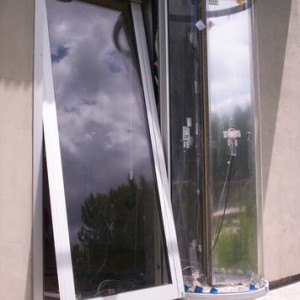To present the project for creating, developing and producing the eco-efficient window (EEW), ECO123 interviewed its creator, architect Miguel Veríssimo.
ECO 123 – What led you to design this window?
Miguel Veríssimo – The EEW is a project dating from 2005/07. It arose from a practical need: a lack of eco-efficient building solutions on the market that could be mass produced, are easy to apply and are able to guarantee results when fitted in buildings. Once the idea was launched, I set up partnerships with the Physics and Technology of Buildings Laboratory at the University of Minho and with a manufacturing partner (Sapa), which have been very fruitful and worked well for everyone…
How does it work? What are its main characteristics and advantages?

The EEW uses the sun as a source of energy for heating or cooling through the convection, conduction and radiation of heat. As compared with current window systems, it has two main competitive advantages: it enables energy for heating and cooling to be saved, and, as this saving represents an added value, the EEW pays for itself over time: the break-even period is between 7 and 10 years depending on the local climate.
Is it easy to produce?
Relatively. There is still room for improvement in the production cycle and process, but in order to have the eco-efficiency stamp on the concept, and as we are rigorous in the application of concepts, the EEW has to comply with certain efficiency norms. This means that we have to think about complexity in a simple way.
The product is already a few years old; how effective has it been in the market, and in terms of sales?
As it is a pioneering project, it has suffered from anachronism and the socio-cultural resilience of the market. The need to reduce energy consumption and buildings’ ecological footprint is only now beginning to be accepted as an asset for overcoming the crisis!
At the time it was created, the EEW focused on the anticipated boom in the market segment which was at a standstill – the refurbishing of buildings constructed between the 1960s and the later 1980s (the majority of residential properties). With the growth of this market, there has been renewed interest in the EEW! I have been contacted by large numbers of promoters asking me about the technology and how it works.
What is needed for good ecological ideas to be developed and to last?
Change the way of thinking about and structuring value chains. In all sectors…
In anticipation of the huge impact of shortages of energy and raw materials, people have been thinking about change, trying to get the richer societies to react, to reduce waste and its impact on ecosystems, and reviewing the model of development.
Driven by this scenario, technological development has been impressive. Technical and technological solutions are appearing more quickly than cultural ones! Soon, in 2020, it will only be permitted to construct buildings that produce energy instead of consuming it (1). This will require a total revolution in mentalities and a giant leap in the training of specialists.
 Since 1994, Miguel Veríssimo has been a pioneer at the intersection of architecture, energy and ecology. In 1999, he set up Armadilha Solar – arquitectura, with the mission of achieving and exceeding state-of-the-art results in the fields of eco-architecture, eco-urban development and eco-construction. In 2007, he won the BES National Innovation Award with the EEW. He recently developed the project MUSCLE in the field of urban regeneration, ECO urban development and “Smart Cities”.
Since 1994, Miguel Veríssimo has been a pioneer at the intersection of architecture, energy and ecology. In 1999, he set up Armadilha Solar – arquitectura, with the mission of achieving and exceeding state-of-the-art results in the fields of eco-architecture, eco-urban development and eco-construction. In 2007, he won the BES National Innovation Award with the EEW. He recently developed the project MUSCLE in the field of urban regeneration, ECO urban development and “Smart Cities”.
 Eco123 Revista da Economia e Ecologia
Eco123 Revista da Economia e Ecologia

